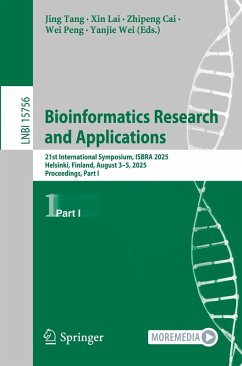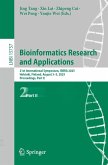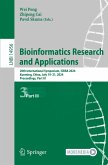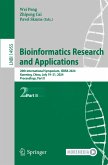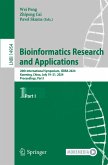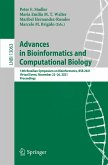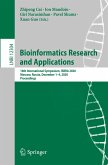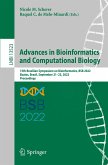Bioinformatics Research and Applications
21st International Symposium, ISBRA 2025, Helsinki, Finland, August 3-5, 2025, Proceedings, Part I
Herausgegeben:Tang, Jing; Lai, Xin; Cai, Zhipeng; Peng, Wei; Wei, Yanjie
Bioinformatics Research and Applications
21st International Symposium, ISBRA 2025, Helsinki, Finland, August 3-5, 2025, Proceedings, Part I
Herausgegeben:Tang, Jing; Lai, Xin; Cai, Zhipeng; Peng, Wei; Wei, Yanjie
- Broschiertes Buch
- Merkliste
- Auf die Merkliste
- Bewerten Bewerten
- Teilen
- Produkt teilen
- Produkterinnerung
- Produkterinnerung
This two-set volume LNCS 15756 and 15767 constitutes the refereed proceedings of the 21st International Symposium on Bioinformatics Research and Applications, ISBRA 2025, held in Helsinki, Finland, during August 3 5, 2025.
The 66 full papers were carefully reviewed and selected from 167 submissions. This year s symposium brought together leading researchers, scientists, and industry professionals from around the world to share cutting-edge advancements, foster collaboration, and explore the future of bioinformatics and computational biology.
Andere Kunden interessierten sich auch für
![Bioinformatics Research and Applications Bioinformatics Research and Applications]() Bioinformatics Research and Applications50,99 €
Bioinformatics Research and Applications50,99 €![Bioinformatics Research and Applications Bioinformatics Research and Applications]() Bioinformatics Research and Applications42,99 €
Bioinformatics Research and Applications42,99 €![Bioinformatics Research and Applications Bioinformatics Research and Applications]() Bioinformatics Research and Applications68,99 €
Bioinformatics Research and Applications68,99 €![Bioinformatics Research and Applications Bioinformatics Research and Applications]() Bioinformatics Research and Applications68,99 €
Bioinformatics Research and Applications68,99 €![Advances in Bioinformatics and Computational Biology Advances in Bioinformatics and Computational Biology]() Advances in Bioinformatics and Computational Biology42,99 €
Advances in Bioinformatics and Computational Biology42,99 €![Bioinformatics Research and Applications Bioinformatics Research and Applications]() Bioinformatics Research and Applications38,99 €
Bioinformatics Research and Applications38,99 €![Advances in Bioinformatics and Computational Biology Advances in Bioinformatics and Computational Biology]() Advances in Bioinformatics and Computational Biology42,99 €
Advances in Bioinformatics and Computational Biology42,99 €-
-
-
This two-set volume LNCS 15756 and 15767 constitutes the refereed proceedings of the 21st International Symposium on Bioinformatics Research and Applications, ISBRA 2025, held in Helsinki, Finland, during August 3 5, 2025.
The 66 full papers were carefully reviewed and selected from 167 submissions. This year s symposium brought together leading researchers, scientists, and industry professionals from around the world to share cutting-edge advancements, foster collaboration, and explore the future of bioinformatics and computational biology.
The 66 full papers were carefully reviewed and selected from 167 submissions. This year s symposium brought together leading researchers, scientists, and industry professionals from around the world to share cutting-edge advancements, foster collaboration, and explore the future of bioinformatics and computational biology.
Produktdetails
- Produktdetails
- Lecture Notes in Computer Science 15756
- Verlag: Springer / Springer Nature Singapore / Springer, Berlin
- Artikelnr. des Verlages: 89549585, 978-981-95-0697-2
- Seitenzahl: 432
- Erscheinungstermin: 1. August 2025
- Englisch
- Abmessung: 235mm x 155mm x 24mm
- Gewicht: 651g
- ISBN-13: 9789819506972
- ISBN-10: 9819506972
- Artikelnr.: 74741549
- Herstellerkennzeichnung
- Springer-Verlag GmbH
- Tiergartenstr. 17
- 69121 Heidelberg
- ProductSafety@springernature.com
- Lecture Notes in Computer Science 15756
- Verlag: Springer / Springer Nature Singapore / Springer, Berlin
- Artikelnr. des Verlages: 89549585, 978-981-95-0697-2
- Seitenzahl: 432
- Erscheinungstermin: 1. August 2025
- Englisch
- Abmessung: 235mm x 155mm x 24mm
- Gewicht: 651g
- ISBN-13: 9789819506972
- ISBN-10: 9819506972
- Artikelnr.: 74741549
- Herstellerkennzeichnung
- Springer-Verlag GmbH
- Tiergartenstr. 17
- 69121 Heidelberg
- ProductSafety@springernature.com
HCSeer: A Classification Tool for Human Genetic Variant Hot and Cold Spots Designed for PM1 and Benign Criteria in the ACMG Guideline.- ViDSG: A Hybrid Algorithm Integrating Statistical and Semantic Features via Dual-Channels for Identifying Prokaryotic and Eukaryotic Viruses.- MoGE: A Benchmark for Comprehensive Evaluation of Molecular Generation Models in De Novo Drug Design.- Dual-Modality Representation Learning for Molecular Property Prediction.- GDMRMD: An Ensemble Model for Predicting RNA Modification-Disease Associations.- SUIFS: A Symmetric Uncertainty based Interactive Feature Selection Method.- TF-GCNNovo: A Peptide Sequence Prediction Model Integrating Transformer and Graph Convolutional Network.- FSPicker: A Dual-Stream Attention Network for Multi-Scale Particle Picking in Cryo-Electron Tomography.- SDMFF: Spatial-temporal Dual-pathway Network with Multi-scale Feature Fusion for Parkinson s Disease Diagnosis.- RNA-ModCaller: A Multi Feature Fusion and Stacking Ensemble Learning Framework for Prediction of RNA Modifications.- Efficient and Accurate Approximation Algorithms for Protein Structure Alignment.- Multi-Task Learning with Cross-Stitch for Synergistic Effect of Drug Combination Prediction.- A Neighborhood Selection Learning Artificial Bee Colony Algorithm Based on Population Backtracking for Detecting Epistatic Interactions.- PDA-GTGCN: identification of piRNA-disease associations based on group feature transformation graph convolutional network.- DDLB: Using the protein language model and hierarchical architecture to improve disordered lipid-binding residues prediction.- EEG-TFNet: Spatiotemporal and Spectral Feature Integration for EEG-Based AD Detection.- RGMI: a multimodal graph framework with dynamic weighting for measuring disease similarity.- LDADW: An algorithm for integrating single-cell and spatial transcriptomic data based on the topic model.- Adaptive Fusion of Global and Local Representations for Neoantigen Retention Time Prediction through Hierarchical Sequence-Graph Hybridization.- MambaST: Hexagonal State Space Modeling for Spatial Domain Identification.- On Multiple Protein Scaffold Filling.- RGNCNDDA: Predicting Potential Drug-Disease Associations via Residual Graph Normalized Convolutional Network.- Spindle-UMamba: A Mamba-based Attention-Unet Framework for Effective Sleep Spindle Detection.- CADS: Causal Inference for Dissecting Essential Genes to Predict Drug Synergy.- A Novel Sample Selection for Deep Learning Model in Computational Drug Repositioning.- SGMDTI: A unified framework for drug-target interaction prediction by semantic-guided meta-path method.- TREPP: Tandem Repeat Expansion Pathogenicity Predicting Approach Using Stacked CatBoost Models and Multiple Features.- EMF: Enhancing Mortality Risk Prediction via Evidential Multimodal Fusion.- Contrastive Learning-based Method for Single-cell Multi-omics Data Clustering.- Intelligent algorithms of action recognition for cardiopulmonary resuscitation based on wearable device.- Label-guided graph contrastive learning for single-cell fusion clustering.- A Graph Convolution-Based Method for dental Image Registration.- DepMambaformer: Integrating Bidirectional State Space Duality Model with Multimodal Attention for Depression Detection.
HCSeer: A Classification Tool for Human Genetic Variant Hot and Cold Spots Designed for PM1 and Benign Criteria in the ACMG Guideline.- ViDSG: A Hybrid Algorithm Integrating Statistical and Semantic Features via Dual-Channels for Identifying Prokaryotic and Eukaryotic Viruses.- MoGE: A Benchmark for Comprehensive Evaluation of Molecular Generation Models in De Novo Drug Design.- Dual-Modality Representation Learning for Molecular Property Prediction.- GDMRMD: An Ensemble Model for Predicting RNA Modification-Disease Associations.- SUIFS: A Symmetric Uncertainty based Interactive Feature Selection Method.- TF-GCNNovo: A Peptide Sequence Prediction Model Integrating Transformer and Graph Convolutional Network.- FSPicker: A Dual-Stream Attention Network for Multi-Scale Particle Picking in Cryo-Electron Tomography.- SDMFF: Spatial-temporal Dual-pathway Network with Multi-scale Feature Fusion for Parkinson s Disease Diagnosis.- RNA-ModCaller: A Multi Feature Fusion and Stacking Ensemble Learning Framework for Prediction of RNA Modifications.- Efficient and Accurate Approximation Algorithms for Protein Structure Alignment.- Multi-Task Learning with Cross-Stitch for Synergistic Effect of Drug Combination Prediction.- A Neighborhood Selection Learning Artificial Bee Colony Algorithm Based on Population Backtracking for Detecting Epistatic Interactions.- PDA-GTGCN: identification of piRNA-disease associations based on group feature transformation graph convolutional network.- DDLB: Using the protein language model and hierarchical architecture to improve disordered lipid-binding residues prediction.- EEG-TFNet: Spatiotemporal and Spectral Feature Integration for EEG-Based AD Detection.- RGMI: a multimodal graph framework with dynamic weighting for measuring disease similarity.- LDADW: An algorithm for integrating single-cell and spatial transcriptomic data based on the topic model.- Adaptive Fusion of Global and Local Representations for Neoantigen Retention Time Prediction through Hierarchical Sequence-Graph Hybridization.- MambaST: Hexagonal State Space Modeling for Spatial Domain Identification.- On Multiple Protein Scaffold Filling.- RGNCNDDA: Predicting Potential Drug-Disease Associations via Residual Graph Normalized Convolutional Network.- Spindle-UMamba: A Mamba-based Attention-Unet Framework for Effective Sleep Spindle Detection.- CADS: Causal Inference for Dissecting Essential Genes to Predict Drug Synergy.- A Novel Sample Selection for Deep Learning Model in Computational Drug Repositioning.- SGMDTI: A unified framework for drug-target interaction prediction by semantic-guided meta-path method.- TREPP: Tandem Repeat Expansion Pathogenicity Predicting Approach Using Stacked CatBoost Models and Multiple Features.- EMF: Enhancing Mortality Risk Prediction via Evidential Multimodal Fusion.- Contrastive Learning-based Method for Single-cell Multi-omics Data Clustering.- Intelligent algorithms of action recognition for cardiopulmonary resuscitation based on wearable device.- Label-guided graph contrastive learning for single-cell fusion clustering.- A Graph Convolution-Based Method for dental Image Registration.- DepMambaformer: Integrating Bidirectional State Space Duality Model with Multimodal Attention for Depression Detection.

